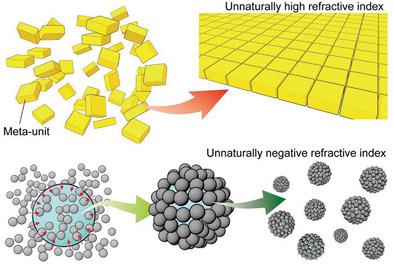当前位置:
X-MOL 学术
›
Adv. Mater.
›
论文详情
Our official English website, www.x-mol.net, welcomes your feedback! (Note: you will need to create a separate account there.)
Exploiting Colloidal Metamaterials for Achieving Unnatural Optical Refractions
Advanced Materials ( IF 29.4 ) Pub Date : 2020-10-20 , DOI: 10.1002/adma.202001806 Ji‐Hyeok Huh 1 , Kwangjin Kim 1 , Eunji Im 2 , Jaewon Lee 1 , YongDeok Cho 1 , Seungwoo Lee 1, 2, 3
Advanced Materials ( IF 29.4 ) Pub Date : 2020-10-20 , DOI: 10.1002/adma.202001806 Ji‐Hyeok Huh 1 , Kwangjin Kim 1 , Eunji Im 2 , Jaewon Lee 1 , YongDeok Cho 1 , Seungwoo Lee 1, 2, 3
Affiliation

|
The scaling down of meta‐atoms or metamolecules (collectively denoted as metaunits) is a long‐lasting issue from the time when the concept of metamaterials was first suggested. According to the effective medium theory, which is the foundational concept of metamaterials, the structural sizes of meta‐units should be much smaller than the working wavelengths (e.g., << 1/5 wavelength). At relatively low frequency regimes (e.g., microwave and terahertz), the conventional monolithic lithography can readily address the materialization of metamaterials. However, it is still challenging to fabricate optical metamaterials (metamaterials working at optical frequencies such as the visible and near‐infrared regimes) through the lithographic approaches. This serves as the rationale for using colloidal self‐assembly as a strategy for the realization of optical metamaterials. Colloidal self‐assembly can address various critical issues associated with the materialization of optical metamaterials, such as achieving nanogaps over a large area, increasing true 3D structural complexities, and cost‐effective processing, which all are difficult to attain through monolithic lithography. Nevertheless, colloidal self‐assembly is still a toolset underutilized by optical engineers. Here, the design principle of the colloidally self‐assembled optical metamaterials exhibiting unnatural refractions, the practical challenge of relevant experiments, and the future opportunities are critically reviewed.
中文翻译:

利用胶体超材料实现不自然的光学折射
从首次提出超材料的概念开始,缩小亚原子或超分子(统称为元单元)的规模就成为一个长期存在的问题。根据有效介质理论,这是超材料的基本概念,超单元的结构尺寸应远小于工作波长(例如<< 1/5波长)。在相对较低的频率范围(例如微波和太赫兹)下,常规的单片光刻技术可以轻松解决超材料的实现问题。然而,通过光刻方法制造光学超材料(在可见光和近红外等光学频率下工作的超材料)仍然具有挑战性。这是使用胶体自组装作为实现光学超材料的策略的基本原理。胶体自组装可以解决与光学超材料的物化相关的各种关键问题,例如在大面积上实现纳米间隙,增加真正的3D结构复杂性以及具有成本效益的加工,而这些都是通过单片光刻很难实现的。尽管如此,胶体自组装仍然是光学工程师未充分利用的工具集。在此,对具有不自然折射的胶体自组装光学超材料的设计原理,相关实验的实际挑战以及未来的机会进行了严格的审查。胶体自组装可以解决与光学超材料的物化相关的各种关键问题,例如在大面积上实现纳米间隙,增加真正的3D结构复杂性以及具有成本效益的加工,而这些都是通过单片光刻很难实现的。尽管如此,胶体自组装仍然是光学工程师未充分利用的工具集。在此,对具有非自然折射的胶体自组装光学超材料的设计原理,相关实验的实际挑战以及未来的机会进行了严格的审查。胶体自组装可以解决与光学超材料的物化相关的各种关键问题,例如在大面积上实现纳米间隙,增加真正的3D结构复杂性以及具有成本效益的加工,而这些都是通过单片光刻很难实现的。尽管如此,胶体自组装仍然是光学工程师未充分利用的工具集。在此,对具有非自然折射的胶体自组装光学超材料的设计原理,相关实验的实际挑战以及未来的机会进行了严格的审查。胶体自组装仍然是光学工程师未充分利用的工具集。在此,对具有非自然折射的胶体自组装光学超材料的设计原理,相关实验的实际挑战以及未来的机会进行了严格的审查。胶体自组装仍然是光学工程师未充分利用的工具集。在此,对具有不自然折射的胶体自组装光学超材料的设计原理,相关实验的实际挑战以及未来的机会进行了严格的审查。
更新日期:2020-12-22
中文翻译:

利用胶体超材料实现不自然的光学折射
从首次提出超材料的概念开始,缩小亚原子或超分子(统称为元单元)的规模就成为一个长期存在的问题。根据有效介质理论,这是超材料的基本概念,超单元的结构尺寸应远小于工作波长(例如<< 1/5波长)。在相对较低的频率范围(例如微波和太赫兹)下,常规的单片光刻技术可以轻松解决超材料的实现问题。然而,通过光刻方法制造光学超材料(在可见光和近红外等光学频率下工作的超材料)仍然具有挑战性。这是使用胶体自组装作为实现光学超材料的策略的基本原理。胶体自组装可以解决与光学超材料的物化相关的各种关键问题,例如在大面积上实现纳米间隙,增加真正的3D结构复杂性以及具有成本效益的加工,而这些都是通过单片光刻很难实现的。尽管如此,胶体自组装仍然是光学工程师未充分利用的工具集。在此,对具有不自然折射的胶体自组装光学超材料的设计原理,相关实验的实际挑战以及未来的机会进行了严格的审查。胶体自组装可以解决与光学超材料的物化相关的各种关键问题,例如在大面积上实现纳米间隙,增加真正的3D结构复杂性以及具有成本效益的加工,而这些都是通过单片光刻很难实现的。尽管如此,胶体自组装仍然是光学工程师未充分利用的工具集。在此,对具有非自然折射的胶体自组装光学超材料的设计原理,相关实验的实际挑战以及未来的机会进行了严格的审查。胶体自组装可以解决与光学超材料的物化相关的各种关键问题,例如在大面积上实现纳米间隙,增加真正的3D结构复杂性以及具有成本效益的加工,而这些都是通过单片光刻很难实现的。尽管如此,胶体自组装仍然是光学工程师未充分利用的工具集。在此,对具有非自然折射的胶体自组装光学超材料的设计原理,相关实验的实际挑战以及未来的机会进行了严格的审查。胶体自组装仍然是光学工程师未充分利用的工具集。在此,对具有非自然折射的胶体自组装光学超材料的设计原理,相关实验的实际挑战以及未来的机会进行了严格的审查。胶体自组装仍然是光学工程师未充分利用的工具集。在此,对具有不自然折射的胶体自组装光学超材料的设计原理,相关实验的实际挑战以及未来的机会进行了严格的审查。



























 京公网安备 11010802027423号
京公网安备 11010802027423号